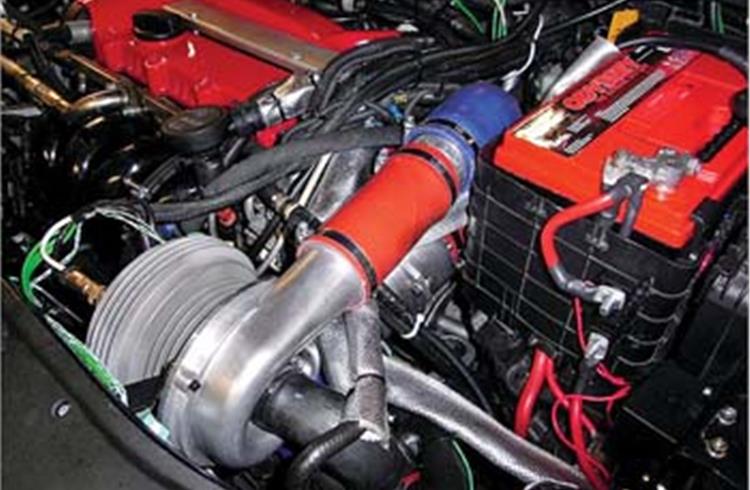CPT & AVL collaborate on advanced direct injection
The AVL demonstrator vehicle incorporates an advanced 2-litre 4-cylinder engine with gasoline direct injection (GDI), double cam phasing and single-scroll, waste-gated turbocharger to deliver high power and torque outputs of 197bhp and 40.7kgm respectively. A system of cooled, external exhaust gas recirculation (EGR), Lambda =1 operation at all engine loads up to 4000rpm and advanced thermal management further enhance the CO2 reduction potential of the powertrain.
Successful down-speeding relies heavily on the immediate availability of high torque levels at very low engine speeds in response to driver inputs. The integration of CPT’s variable torque enhancement system or VTES supercharger technology virtually eliminates all perceptible turbo-lag even in the absence of variable geometry turbine technology normally fitted to turbocharged diesel engines. Through careful integration of the above technologies and the implementation of engine stop-start and smart alternator control, AVL is able to demonstrate CO2 emissions of just 159g/km for a Volkswagen Passat demonstration vehicle at 1,590kg vehicle mass, which also meets Euro 5 emission standards. By way of comparison, a series production Passat emits 165g/km when fitted with a 2.0l TDI (167bhp) diesel engine and 194g/km when fitted with a 2.0l TFSI (197bhp) petrol engine.
At the same time the 197bhp engine delivers high levels of performance and refinement while VTES ensures outstanding transient response even at the lowest engine speeds, equivalent to a naturally aspirated engine of twice the capacity.
“Getting a petrol engine to deliver the lower CO2 emissions of a diesel engine is something of a holy grail for the motor industry,” says Nick Pascoe, chief executive officer, CPT. “The challenge is to retain the driveability at low engine speeds in order that drivers can fully realise the benefits of down-speeding. An electric supercharger can react instantly to these transient load conditions, delivering up to 25kW of additional power at the crankshaft in less than a second.”
RELATED ARTICLES
Branded content: HL Klemove inaugurates first Local ADAS Radar Manufacturing Unit in India, marks a significant achievement in “Make in India” initiative
The inauguration ceremony was held in the presence of Vinod Sahay, President and CPO of Mahindra & Mahindra Ltd. and Dr....
BluWheelz to 'Green Up' logistics sector
With their EVs-as-a-service solution, the startup is playing it smart with costs and looking to electrify the entire seg...
BRANDED CONTENT: Spearheading the EV revolution in India
Jio-bp is a joint venture between Reliance Industries and BP PLC where both entities have married international expertis...





 By Autocar Pro News Desk
By Autocar Pro News Desk
 18 May 2009
18 May 2009
 2919 Views
2919 Views









